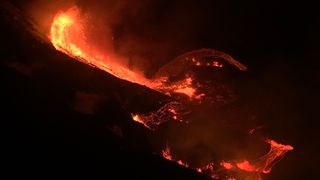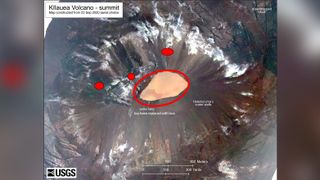Hawaii's Kilauea volcano erupts with dramatic lava fountains

Hawaii's Kilauea volcano erupted beginning Sunday (Dec. 20) night local time, with dramatic lava fountains and huge puffs of gas and steam being launched from the summit crater called Halemaʻumaʻu, the Hawaii Volcano Observatory (HVO), part of the U.S. Geological Survey (USGS), reported.
Though the shield volcano is one of Earth's most active volcanoes, constantly spewing lava from its fissures, the recent eruption is much more dramatic than the "background" streams of lava that consistently flow from volcanic cracks.
"For the past several weeks, the USGS Hawaiian Volcano Observatory has recorded ground deformation and earthquake rates at Kilauea Volcano's summit and upper East Rift Zone that have exceeded background levels," since a 2018 eruption, the observatory said in a statement Sunday.
Related: Photos: Fiery Lava from Kilauea Volcano Erupts on Hawaii's Big Island
Just after 9:30 p.m. HST (2:30 a.m. EST, 7:30 a.m. UTC), the volcano observatory picked up a glow in the crater at Kilauea's summit, just before the eruption began. Several fissures opened up in the walls of the crater, which was filled with water; sizzling lava poured through the cracks and into the lake, causing the water to boil away as it was replaced with the molten rock. The crater's northern fissure sent out a huge lava fountain, extending some 165 feet (50 meters) high, the HVO reported.

About an hour later, at 10:36 p.m. HST (3:36 a.m. EST, 8:36 a.m. UTC), a 4.4-magnitude earthquake shook the ground beneath the volcano's south flank. The center of the earthquake was about 4 miles (6 kilometers) deep and about 8.7 miles (14 km) south of Fern Forest, inside Hawaii Volcanoes National Park. More than 30 earthquakes of magnitude-4 or greater have shook Kilauea's south flank in the past 20 years, according to HVO, with most of them caused by the abrupt movement of the south flank as it moves southeast over the oceanic crust.
"HVO continues to monitor Kīlauea as the situation is rapidly evolving with this evening's eruption at the summit of Kīlauea," David Phillips, HVO's acting scientist-in-charge, said in the statement.
Sign up for the Live Science daily newsletter now
Get the world’s most fascinating discoveries delivered straight to your inbox.
The last dramatic eruption occurred in the spring of 2018 when the floor of the Pu'u 'Ō'ō's crater, on the eastern side of the volcano's rift zone, collapsed on April 30, pushing magma underground southeast, Live Science reported at the time. On May 3, a magnitude-5.0 earthquake struck the Big Island near the Pu'u 'Ō'ō crater. That shaking sent lava racing into residential subdivisions in the Puna district of the Big Island. Mandatory evacuations of the Leilani Estates and Lanipuna Gardens subdivisions followed.
Originally published on Live Science.
Jeanna Bryner is managing editor of Scientific American. Previously she was editor in chief of Live Science and, prior to that, an editor at Scholastic's Science World magazine. Bryner has an English degree from Salisbury University, a master's degree in biogeochemistry and environmental sciences from the University of Maryland and a graduate science journalism degree from New York University. She has worked as a biologist in Florida, where she monitored wetlands and did field surveys for endangered species, including the gorgeous Florida Scrub Jay. She also received an ocean sciences journalism fellowship from the Woods Hole Oceanographic Institution. She is a firm believer that science is for everyone and that just about everything can be viewed through the lens of science.
